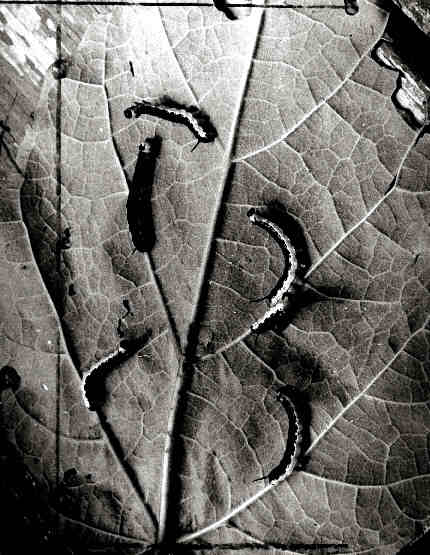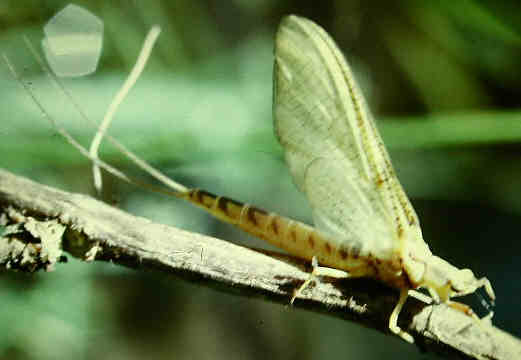| 06-17-02
One of the great features of spring, and summer--which could beat these
words into print--lies in the fact that they offer a wealth of terrific
fish bait.
Throughout the year anglers can rely on the night crawler, the all-American
fish bait, and minnows, to mention some of the old favorite baits. But
when the warm months arrive, millions of insects start thinking of perpetuating
their kind. As a result, their larva, instars, and just plain young offer
some of the best fish bait even though they are time-stamped.
Best-known baits of this kind to Hoosier anglers probably are the catalpa
worm, larval stage of the Catalpa Sphinx, a beautiful moth, and the hellgrammite,
larval stage of the dobsonfly.
The former will be found on the bottom sides of the leaves of some (not
all) catalpa trees. Hellgrammites will be found clinging to the bottom
of rocks and other obstructions on the bottom of riffles (fast water) of
streams and rivers.
Catalpa worms of varying sizes are excellent bait for bluegills, channel
catfish and white perch (freshwater drum). It is commonly thought that
a one-inch catalpa worm with head pinched off and turned inside out on
a long-shanked (sunfish) hook is irresistible to bluegills. I would not
pooh-pooh that thinking, but the same worm is just as good for the 'gills,
and not half as nauseating, when merely baited a la earthworm style.
[See Catalpa worm illustration here.]
The hellgrammite will take any species of fish, but is exceptionally
good for smallmouth bass and rock bass (goggle-eyes), probably because
they usually are fished right where they are found--streams and rivers
which constitute favored water of those species of fish.
However, as spring turns to summer and summer to fall, the Hoosier bait
box is occupied by literally thousands of insects, their larva and metamorphic
stages (instars). And most of them catch fish.
When fishing some of the insects, the adult stage is just the thing
(grasshoppers and crickets are prime examples), while in others the nymphal
or maggot stages are the very berries--for example, bee moth larva (wax
worms), mousies or spikes (larval stages of flies used for ice fishing).
But whatever the species, and regardless of what stage fits best
on a hook, the insect world, which flourishes primarily during the warm
months, offers an endless string of good fish bait. The exceptions I have
found, are the dragonflies, damselflies and ants.
Many artists who try to portray nature in their paintings find it difficult
not to paint a beautiful dragonfly perched on a lily pad while a humongous
bass lurks with his nose inches below. The paintings suggests that one
twitch on the part of the dragon will touch off an explosion of nuclear
proportions as Mr. Largemouth collects his din-din.
Interestingly enough, having checked the stomach contents of thousands
of bass and bluegills over the years (as I "cleaned" them), I have found
the remains of only one dragonfly or damselfly. I figure that bass simply
was starving.
Mother Nature, it seems, gives some insects built-in protection from
birds, fish, animals, and even other insects. For example, have you ever
observed a bird chasing butterflies? Yet a hatch of Mayflies emerging from
a stream or river bottom--taking to the air to find a place to deposit
their eggs--will transform unlikely bird species into aerobatic daredevils
as they (ungraceful as they are) snatch lunch from the air. [See
Mayfly illustration here.]
So, if you try an insect for fish bait without success, it may be that
you were a loser from the start. It may be that the fish knew your offering
just wasn't palatable.
On the other hand, the lower forms of life do not come with signs attached
that read "I TASTE GREAT." That makes natural bait fishing a matter of
trial and error.
Once while fishing a small Southern Indiana lake for bluegills and bass
with those big, yellow, no-fly, just-hop grasshoppers in the fall, a beautiful
aqua blue "worm" crawled up my trouser leg just a I was preparing to bait
up.
"Wonder if that would be a good bait?" I asked myself.
The inch-long larva was a very good bait (helped me put several bluegills
in the boat), but I have always wondered what it would have been (it was
obviously the larva of some moth) had I allowed it to pupate and emerge
as an adult insect.
On another occasion, while crossing the Muscatauck River on a large
log jam (simply to get to the far bank to fish grasshoppers), I noticed
small openings in the logs which would permit dropping bait into the dark
water 10 feet below.
My afternoon of fishing ended right there. Almost every time I dropped
a hopper into the water, something grabbed it. I finally quit with a great
mixed bag of fish when something of monster proportions took several yards
of my line.

|

|
|
Catalpa
Worms
This
larval stage of the Catalpa Sphinx moth occurs on the under side of catalpa
leaves. But not all catalpa trees have suitable chemistry to attract
the adult moth which deposits its white eggs on the under side of catalpa
leaves. Catalpa worms feed on catalpa leaves before pupating and
turning into moths, probably the following year. |
Mayfly
Mayflies
occur in many sizes . . . this one was more than an inch long and was the
downfall of a white bass that turned its nose up to a minnow. Hatches of
Mayflies usually occur late in the afternoon. This gives the mayflies time
to deposit their eggs at night when birds are least active. |
|

